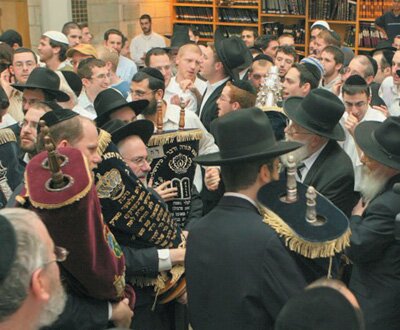| Rejoicing in the Torah |

|

|
|
Shemini Atzeret, or the Eighth Day of Assembly, is on the 22nd of Tishrei. The holiday, while immediately following the seventh day of Sukkot, is actually considered to be a holiday on its own. Simchat Torah falls the second day of Shemini Atzeret for Diaspora Jews. Israelis do not separate the two festivals into distinctive events. Shemini Atzeret is referenced in the book of Numbers (29:35). The Sukkah and the Four Species are no longer used. A prayer for rain is recited and added to the Amidah. Simchat Torah, literally means Rejoicing in the Torah, marks the completion of the Torah. There is, however, no Biblical reference for this festival and the roots have been traced back only as far as the eleventh century. Children crowd the synagogue and wave beautifully adorned flags. Often the flags are home made and colourful ribbons adorn these expressions of joy. In many communities children also carry candy apples and participants throw sweets.
The holiday is characterised by a frenzy of joyous and spontaneous dancing and singing. Children are swept up with the crowds. The congregants parade around the synagogue. Seven rotations are made around the synagogue. Seven perhaps is representative of seven days of the week and therefore completing the cycle of creation. The congregants take all the Torahs out from the ark and parade around with them. The eve of Simchat Torah is the only evening in which the Torah is read at night. The service concludes with the final verses of Deuteronomy. In the morning, the festivities continue. In traditional communities, every man in the synagogue is called to the Torah and given an aliyah. The greatest honours however are reserved for the Chatan Torah (Groom of the Torah) and Chatan Bereshit (Groom of Bereshit), those selected to recite the final verses and beginning verses of the Torah respectively. The last parsha is read and immediately after the fi rst parsha is read, thus Genesis immediately follows Deuteronomywithout pause or hesitation. This act symbolises the continuity of the Jewish people. The cycles, rituals and values of our ancestors are continuously renewed with each generation. There is a rejoicing not so much as over the completion of the Torah but over the new start and the unbroken chain of dedication and faith. A special custom called Kol Hane’arim calls upon all children below bar and bat mitzvah age to be called to the Torah. A talllit is held above the children’s heads, as they congregate on the bima, as part of one of the final aliyot. The mood is joyous and spirited. Melodies that symbolise other holidays are interjected as a reminder of the serious commitment to Torah that Jews have even amidst the seemingly chaotic and frenzied celebration. Simchat Torah also is marked by wedding symbolism and is viewed as the wedding of the Jewish people to Torah. The seven encirclements are also powerful symbols reminiscent of wedding rituals, hence the reference to the bridegroom of Torah and the bridegroom of Bereshit. The power of the symbols of Simchat Torah to connect us to our people and our heritage is relived each year. Old and young join one another to make a continuous procession around the synagogue. The Torah is passed around, from person to person. Children are given the honor of carrying some of the smaller Torahs and all, even the smallest, are given an aliyot and made into active participants. (Issue October 2008)
|


















